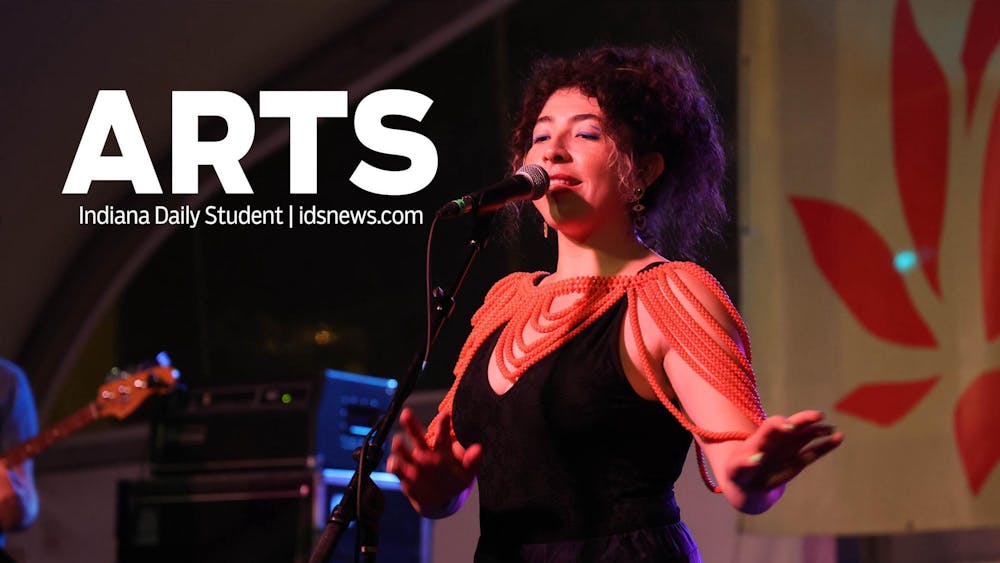At first glance, the IU Art Museum's installation of Man Ray's Revolving Door (1926) prints may appear to be nothing but an abstract Rorschach test, subject to free associations and loose interpretations. But after close examination of both the titles and accompanying text the true talent and voice of the early twentieth century artist can be seen and heard. \nMan Ray, born Emmanuel Radnitzsky, was an American photographer, filmmaker, sculptor and painter, who lived in Paris until the German occupation in 1940. As a young man, Man Ray was influenced and involved in the Dadaist movement and participated in the First International Dada Show held in Paris. The movement was concerned with form, imagery, and color, but most important was the "idea" encompassed in the work. \nThe Revolving Door prints are a set of 10 primary color prints of collages representing an array of different ideas and objects. The order of the prints is thought to be arranged in the same order in which he created them. This progression of images allows for insight into Man Ray's own thought processes and the connections he drew between imagination and everyday life. \n"In his earlier collages, the message was simply about pattern and color, whereas the later ones seem to have more objects as the center of the message," said Nan Brewer, curator of works on paper for the Art Museum.\n"So much of his work was about form and color on a flat two-dimensional surface," said Brewer, "When the colors began to fade, the work was no longer maintaining the original impact of vibrancy." \nAlthough the works are termed "prints," this does not refer to a reproduction of his work. Instead, Man Ray recreated his works in a different medium. When the Revolving Door prints were originally displayed, the prints were organized around a central pole, resembling a revolving door. His intention was for the viewer to interact with the piece, flipping through the different prints and each time opening another "door." \n"Man Ray wanted viewers to interact with the piece, he wanted them to think of it as opening into another way of thinking, or opening a door into the realm of imagination," said Brewer.\nIn addition to the revolving arrangement, there was a long and rambling narrative that accompanies the collection. Although it discusses the prints, it is more a collection of Man Ray\'s own images and thoughts arranged in a free association to allow the viewer space to create his or her own ideas about the work. \nMan Ray was strongly influenced by primary colors, the illusion of overlapping colors and the transparency of colors. He tended to combine abstract design with recognizable objects, as is seen in the third print in the Revolving Door series, titled Orchestra. Here a music stand and the pegs, head and tailpiece of a stringed instrument can be recognized in the vibrant collage. His work tended to push the limits and formal qualities of abstract design.\n"It's a little hard for us realize how shocking these prints truly are," said Brewer. "But when you think back to the dates they were created -- well, people thought they were really avant-garde, revolutionary work. Now collage is very much accepted as a form of art, but in the early twentieth century, the idea of cutting paper and sticking it on to other paper and calling it art was unheard of."\nThe installation appears in the Art Museum in conjunction with "Jazz in July," an event which showcases jazz performances each Friday night during the month of July. Brewer said, "Quality of music was influential and inspirational to Man Ray's work and the viewer can draw a number of ties to early jazz music."\n"It is our hope that people will come to hear the jazz music and then find that the art influenced by that genre of music, especially that of Man Ray," said Joanna Davis, administrative assistant for development and administration at the Art Museum. "We want to introduce jazz lovers to the museum, and show them that music is truly influential in art."\nThe Man Ray installation will be running through Sept. 30, 2001. The installation is free and open to the public, as are all exhibits in the IU Art Museum, which is located on 7th street in the center of the Bloomington campus.
Man Ray Revolving Door prints on display
Get stories like this in your inbox
Subscribe





